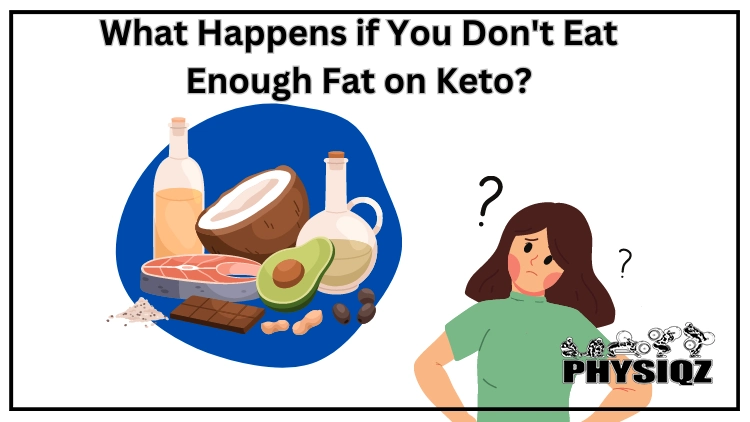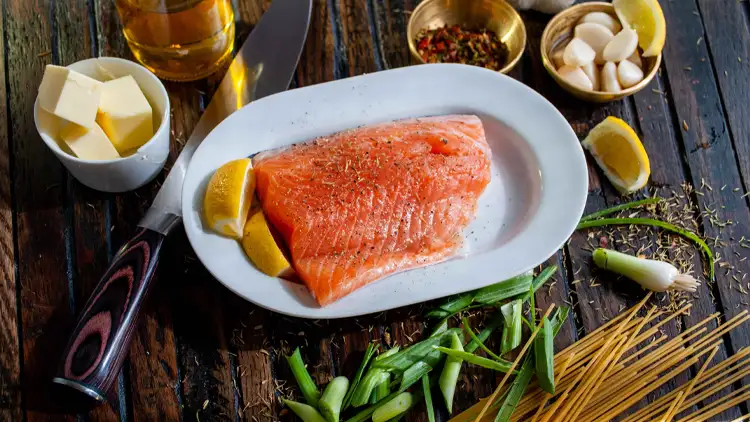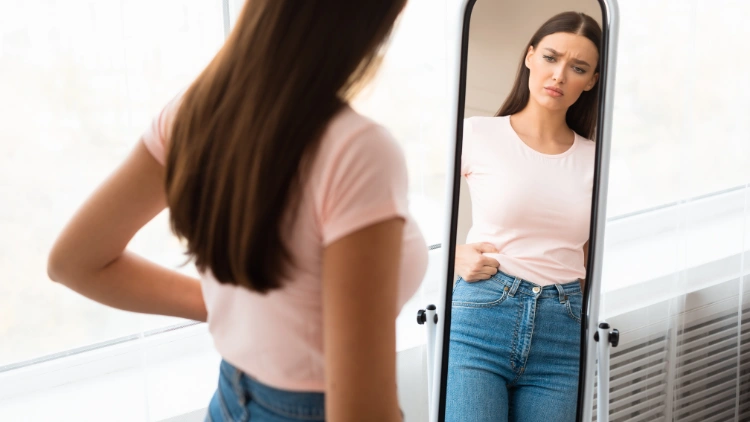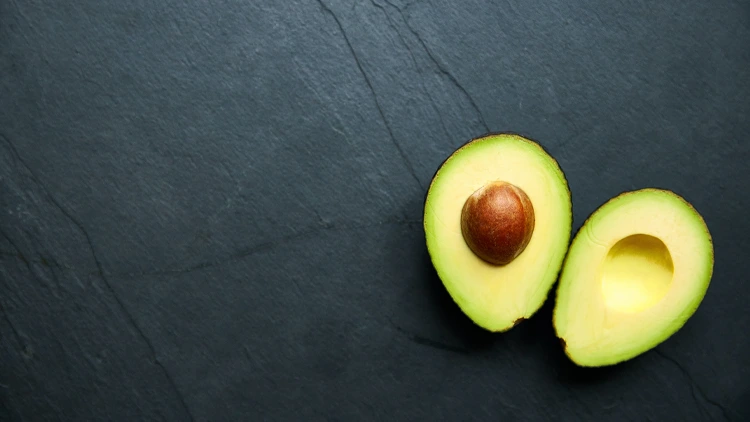
To understand the consequences of not eating enough fat on keto, the information below helps dieters assess if they’re getting enough fats and if they’re consuming the right types of fats before reviewing the potential side effects and risks.1
Not only can a lack of fats be a health concern due to the possibility of nutrient deficiencies and gallstones, but a lack of fat can actually ruin a keto diet since excessive carbs and proteins will kick individuals out of ketosis.
In order to solve this matter, we’ll detail how to get enough healthy fats on keto, provide a list of foods rich in healthy fats, and divulge what happens if you don’t get enough calories on keto as well.
Please note, if you have any of these side effects or have any level of concern, it’s best to speak to a healthcare professional to assess your diet, vitals, and get bloodwork done.
Signs You May Not Be Consuming Enough Healthy Fats
Consuming fat might seem counterproductive to weight loss, but calories are the most important factor and not getting enough calories from fat can cause you to be kicked out of ketosis and may cause health issues.
It can be confusing for beginners to weight loss and long-term dieters alike to understand the consequences of not consuming enough fat on keto, so we’ll review several signs you may not be consuming enough healthy fats to watch out for.
Before getting into the signs and symptoms of a diet low in healthy fats, it’s vital to know what healthy fats are; a study done on the good, bad, and unknown about fat delved deep to uncover more of the previous misconceptions on fat and the demonization of all fats for decades.

Photo by David B Townsend on Unsplash2
Researchers emphasize that some fats are dangerous for our health, but that unsaturated fats are actually good for you and tend to come from nuts, seeds, fatty fish, avocados, and cooking oils that are liquid at room temperature.
Swapping out saturated fats for unsaturated ones can decrease your risk of heart disease by approximately the amount that cholesterol-lowering prescription drugs can.3
We’ll delve deeper into unsaturated, saturated, and trans fats further below–but now that we’ve reviewed what healthy fats are, let’s check out some key signs that you may not be consuming enough fat; symptoms may include experiencing:
- Achy Joints
- Brain Fog
- Chronic Hunger
- Diarrhea
- Disrupted Sleep
- Dry Skin
- Fatigue
- Fluid Retention
- Frequent Cravings
- Frothy Urine
- Hair Loss
- Headaches
- Increased Body Fat
- Increased Hunger
- Insomnia
- Irritability
- Lower Energy Levels
- Mood Swings
- Muscle Cramps
- Nausea
- Restlessness
- Weakened Immune System
Consequences of Insufficient Fat Intake on a Keto Diet
Though we briefly covered many of the symptoms of lacking healthy fats on the keto diet, we’ll go deeper into several of these signs and cover a few more as well to better explain what the body experiences and what you may feel if your keto fat intake is insufficient.
Many of these symptoms are uncomfortable and can cause one to feel overwhelmed or discouraged, especially if weight loss has temporarily plateaued or multiple symptoms of fat deficiencies are happening simultaneously.
Rather than being hard on yourself or giving up on weight loss, take a moment to breathe, recollect your thoughts and reassess your diet to find ways to add healthy fats and ensure proper nutrition. Many people on diets–specifically keto–have a slip up here or there but it’s entirely possible to get back on track with your weight loss and continue striving to meet your goals.
Although it can feel like you’ve ruined your diet, this doesn’t have to be the case by any means–unless you let it.
Instead, it’s important to realize that even though you may have unwittingly been kicked out of ketosis, your diet and weight loss can both certainly continue; in fact, within just a few days you can get back into ketosis and accept that this was merely a speed bump.
Keep in mind that 70-80% of daily calories should come from healthy fats, 10-20% from protein, and just 5-10% from carbs.
Furthermore, if you remained in a caloric deficit when ketosis was broken, you may not even have any weight plateau or gain. Now let’s get into what can happen if not enough fat is consumed on keto and how the body is affected.
Increased Risk of Gallstones
When the body doesn’t get enough fat intake, it stops producing as much bile and other digestive fluids. Simultaneously, less of the digestive fluid will be removed from the gallbladder due to this imbalance, which can lead to an increased likelihood of developing painful gallstones (hard deposits of these digestive fluids) that may need to be surgically removed.
Fatigue
When you’re in ketosis, most of your energy comes from consuming and burning fat–so when you’re not consuming enough fat anymore, you’ll experience drastically decreased energy levels as the body is essentially running on fumes and basic functions become more difficult.
When the primary energy source is depleted, it can impact all aspects of daily life and make you feel extremely exhausted.
Craving Carbs & Highly Processed Foods
Lacking healthy fats on keto will leave you feeling constantly hungry, since these fats are very satiating–meaning they make you feel fuller for longer.
Not only will you be more likely to make poor food choices due to chronic hunger, but lacking those healthy fats can throw off blood glucose levels as well and cause cravings for sugar, carbs, and highly processed unhealthy snacks and foods.
Digestive Issues
Similar to the cause of gallstones, a lack of bile and digestive fluids and enzymes in your system can cause abdominal cramping, discomfort, and chronic diarrhea if you go too long without consuming healthy fats or consume too few. Bile not only aids in digesting food, but helps break down fat soluble vitamins as well.
Since fat intake is what triggers bile secretion into the gut to promote digestive health, lacking these healthy fats can cause both digestive problems and issues with bowel movements.
Protein Poisoning
Another aspect of the consequences of not consuming enough fat on keto is called protein poisoning–meaning the body is mainly consuming lean proteins and is malnourished in both fats and carbs. This can be dangerous especially if not quickly corrected, and can have side effects like nausea, confusion, nutrient deficiency, and diarrhea.
Nutrient & Vitamin Deficiencies
Nutrient deficiency is very easy to fall into even without being in ketosis, so anyone on keto must be especially cautious and mindful of getting sufficient nutrients. Fat-soluble vitamins need to be consumed with fats to be properly digested and used by the body.
These vitamins are often found in many plant and animal foods and supplements and include vitamins A, D, E and K2. Deficiency of micronutrients iron, folate, and vitamins A and B12 can quickly lead to anemia, weakness, and dizziness. Without these vitamins and nutrients, you may notice a weakened immune system and poor gut health as well.
Weight Gain
When ketosis is broken, the body will end ketone production and most consumed sugars will begin replacing stores of glycogen. Since every gram of glycogen stored in the body attaches to 3-4 grams of water, you can gain a lot of water weight in a short amount of time.

Source: Prostock-Studio via Canva.com4
The good news is that since this is water weight, getting back into ketosis can help you quickly shed the excess water again as these stores are depleted.
How to Ensure You Get Enough Fat on a Keto Diet
When it comes to fats and cholesterol and ensuring you’re consuming enough fat on the ketogenic diet, the type of fat consumed is extremely important.
Although many hold the misconception that any fat is bad and causes weight gain, this has been proven false; instead, it’s important to eat healthy fats that don’t instantly cause weight gain but can even help burn fat.
It seems counterintuitive, but let’s look further: unsaturated fats (monounsaturated or polyunsaturated) actually carry many health benefits, including lowering risk of heart disease, decreasing “good” HDL cholesterol, and increasing “bad” LDL cholesterol.
On the other hand, saturated fats such as cheese, butter, red meats, coconut and palm oils, and many desserts can be enjoyed occasionally but should be fairly limited because they can raise LDL cholesterol and increase risk of cardiovascular disease or stroke. Again, it’s okay to cook with the best coconut oil for keto or indulge in your favorite type of cake from time to time, as these should be limited but don’t need to be cut completely.
Trans fats–often in highly processed foods–increase risk of health issues and illnesses and should be avoided.5 The toxicity of dietary trans fats is all the more dire when we learn that consumption of trans fatty acids are a prominent cause of heart disease, strokes, and heart attacks.6
Since these categories can be tricky to keep track of, we’ve created a table below with some food categories and fat-rich foods under each.
| Keto Fat Sources | |
| Fruits | Meats |
| Avocado Blackberries Blueberries Coconut Olives Raspberries Strawberries | Beef Chicken Lamb Pork Belly Ribs Steak |
| Dairy | Fish |
| Butter (in moderation) Cheese (in moderation) Cream Greek Yogurt Whole Milk | Anchovies Herring Mackerel Salmon Sardines Tuna |
How Does Consuming Fat Aid in Weight Loss on the Keto Diet?
After covering fat’s satiation effect on the body, let’s review other ways that fat intake promotes weight loss.
First, decreasing fat consumption can slow or reduce nearly all body functions from cell development to metabolism; so when someone decreases fat intake hoping to lose weight, they’re actually slowing their metabolism and making it harder to lose weight. Furthermore, the body will notice this change and adjust accordingly, beginning to store fat again instead of burning it so body fat percentage will increase.
When we consider the vitamins that aid in weight loss, it becomes apparent that many of these overlap with the fat-soluble vitamins we reviewed previously–so if you lack the fat that helps absorb these vitamins, you’re missing out on all of their benefits, including weight loss promotion.

Photo by Dirk Ribbler on Unsplash7
Healthy fats like avocado, fish, and nuts can lower LDL “bad” cholesterol levels; in fact, avocado is one of the best options for getting sufficient healthy fats–so much so that avocado nutritional information states that in just a 100 gram serving of avocado there is 15g fat and 7g protein–making it a very healthy fat and ideal for keto.8
All in all, keep in mind that eating fat doesn’t make you fat–as long as you’re consuming healthy fats, they can actually boost weight loss potential.
What Are the Effects of Not Eating Enough Calories on a Keto Diet?
As opposed to the effects of insufficient fat intake on keto, let’s assess what can happen when not getting enough calories on keto. Primarily, you’ll notice your weight loss rate speeds up–as long as you’re in a healthy calorie deficit and not completely depleting yourself of calories and food.
It’s vital yet difficult to find a healthy balance between keeping the right ratio of fat, protein, and carbs on keto, maintaining proper nutrition, and consuming enough calories–but not too much.
Be patient and gentle with yourself as finding a good balance is an ongoing endeavor and will be difficult at times, so if you slip up occasionally just make adjustments and get back on track.
However, for those wondering about their weekly weight loss of only a pound and wanting to lose weight at a faster pace, you can incorporate more activity or physical exercise, hone your eating habits to ensure you’re eating clean, make sure you’re getting enough sleep, or try a larger caloric deficit.
Since primarily the result of not eating enough calories on keto is expedited weight loss, it can be very tempting to want to cut out as much as possible and lose weight rapidly–but doing this too extensively can lead to malnutrition, nutrient deficiency, and even starvation.
It’s not sustainable nor healthy to deprive yourself of enough calories to get through each day.
To prevent overdoing a caloric deficit, check out this body weight planner where you’ll be able to easily input your height, weight, goal weight, and activity level to get an instant estimate of the calories you should consume daily to reach your goal weight by a certain date.9
This is a very helpful tool or resource for those who aren’t sure how many net calories to aim for each day.
What Types of Fats, Foods & Ingredients Should Be Avoided on the Ketogenic Diet?
Now that we’ve explained why trans fats should be avoided on the ketogenic diet, we’ll go over other foods and ingredients that you should minimize or avoid altogether on the keto diet.
Although it’s high in saturated fats, butter has mixed reviews regarding its health detriment and the impact of butter on cardiovascular disease, cancer and total mortality may be much smaller than previously believed.
While dietary guidelines used to call for avoiding foods with high saturated fats, newer studies have found that butter consumption was only marginally impactful–if at all–on mortality, type 2 diabetes, or cardiovascular disease.10
With these conflicting recommendations, our advice is to consume butter and other saturated fats only in moderation and to place a much heavier focus on healthy fats.
Other foods and ingredients that should be avoided or vastly limited are:
- Alcohol
- Artificial Dyes
- Candy
- Fried Foods
- Highly Processed Foods
- Preservatives
- Refined Grains
- Sodas
- Sugary Desserts & Pastries
Aside from saying affirmations for dream body, following macro recommendations, healthy habits, and exercise, be sure to get a vast majority of your daily calorie consumption from healthy fats on keto.
Now that we know the consequences of not consuming enough fat on keto, take proactive steps to maintain ketosis and avoid these unpleasant side effects.
Frequently Asked Questions
What Happens if You Don’t Eat Enough Fat on Keto but You Eat a Lot of Protein?
If you eat a high protein diet without enough fat, you’ll not only be kicked out of ketosis but risk nausea, protein poisoning, liver damage, gallstones, and diarrhea. When it comes to not eating enough on keto, this can cause short and long-term health issues so be sure to track your macros and remember that healthy fats are necessary.
How Much Fat per Day on Keto Is Recommended?
How much fat per day on keto breaks down to 70-80% of daily caloric intake being from healthy fats, 10-20% coming from protein, and just 5-10% from carbs.
What Are Some Foods High in Healthy Fats?
Instead of some other diets that call for low fat, keto encourages a high amount of healthy fats. If you’re frustrated or feeling you can’t get enough fat on keto or don’t know what to look for, the following list is a good starting point.
These healthy fats can come from many sources and whole foods including avocados, chia seeds, flax seeds, salmon, tuna, coconut.
References
1@browniemother. Free Design Tool: Presentations, Video, Social Media | Canva. Accessed 25 April 2023. <https://www.canva.com>
2“flat lay photography of raw salmon fish photo – Free Ketogenic diet Image on Unsplash.” Unsplash, 28 May 2019. Accessed 25 April 2023. <https://unsplash.com/photos/fV3zTanbO80>
3Wein, H., & Hicklin, T. (2019, March). The Skinny on Fat: The Good, the Bad, and the Unknown. National Institute of Health. Retrieved March 13, 2023, from <https://newsinhealth.nih.gov/2019/03/skinny-fat>
4Prostock-Studio. Canva. Accessed 25 April 2023. <https://www.canva.com/photos/MAD-zSJyXyE-sad-woman-measuring-waist-after-weight-gain-standing-at-home/>
5The Nutrition Source. (2023). Fats and Cholesterol. Harvard School of Public Health. Retrieved March 13, 2023, from <https://www.hsph.harvard.edu/nutritionsource/what-should-you-eat/fats-and-cholesterol/>
6Ganguly, R., & Pierce, G. (2015, February 12). The toxicity of dietary trans fats. Food and Chemical Toxicology, 78, 170-76. <https://pubmed.ncbi.nlm.nih.gov/25684416/>
7“two green round fruits on gray textile photo – Free Food Image on Unsplash.” Unsplash, 25 May 2020. Accessed 25 April 2023. <https://unsplash.com/photos/xEFoRSMT-x4>
8Food Data Central. (2020, October 30). Avocado, raw. U.S. Department of Agriculture. Retrieved March 13, 2023, from <https://fdc.nal.usda.gov/fdc-app.html#/food-details/1102652/nutrients>
9National Institute of Diabetes and Digestive and Kidney Diseases. (n.d.). Body Weight Planner. National Institutes of Health. Retrieved March 13, 2023, from <https://www.niddk.nih.gov/bwp>
10Pimpin, L., Wu, J., Haskelberg, H., Gobbo, L., & Mozaffarian, D. (2016, June 29). Is Butter Back? A Systematic Review and Meta-Analysis of Butter Consumption and Risk of Cardiovascular Disease, Diabetes, and Total Mortality. PLOS One, 11(6), e158118. <https://pubmed.ncbi.nlm.nih.gov/27355649/>